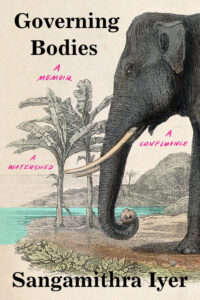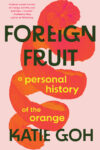
[Milkweed Editions; 2025]
In the 1930s, Sangamithra Iyer’s paternal grandfather left his post as a civil engineer for the British in Burma, returned to India, established an ashram modeled on Gandhi’s teachings, and took up the divining rod as a tool for bringing water access to those living without it. Iyer draws a line between her grandfather’s approach to antiviolent resistance and her own when she walked away from an engineering job to more directly pursue activism. Governing Bodies, Iyer’s new memoir, traces a lineage of moral ideals and asks questions about how to best pursue a life lived in service to them.
Water is one of several motifs that provide continuity throughout a book that refuses direct narrative and frequently shifts focus. In the first section, which is written as a letter to Iyer’s Thatha, or grandfather, she asks his traditional divining rod to let her feel “the passion and conviction of your decision to quit the British, rid yourself of material wealth, and pursue a life of service aligned with your ethics back in Tamil Nadu.” As the forked branch seeks water, Iyer seeks connection to what she believes is the source of her family’s commitment to ethical living. Water is present again as she attempts to find her own path to acting on her inherited ideals. As a trained engineer, she “follow[s] the flow from source water reservoirs to the outfalls of wastewater treatment plants.” Where she paints her grandfather’s transition to activism as sudden and dramatic, hers is less so, and this path-seeking becomes one of the main questions of the book. What is the best way for her, in a different time and place, to live and advocate for a life of nonviolence? When Iyer takes a transformative sabbatical from her engineering work in New York to help solve water supply and drainage problems at a chimp sanctuary in Cameroon her path begins to clarify.
One of the book’s strengths is how it carefully recounts exposure to ideas that accumulate into belief and eventually into action. Iyer describes Gandhi’s ideological development, noting that as a young man he flirted with a burgeoning zeitgeist that equated traditional Hindu vegetarianism with weakness. Iyer traces Gandhi’s encounter with the literature that initiates his belief that “ahimsa [nonviolence] and vegetarianism are key strengths — not weaknesses — in the effort to fight for Indian independence.” In reviewing the salient details of their writing, she tells us that “Tolstoy and Ruskin and Salt influenced Gandhi, who in turn inspired Thatha to start the Kallakurichi Ashram.” Iyer gradually inventories her own influences, one of which is a magazine, Satya, that allows her to make her own jump from engineering to activism. As an undergrad, Iyer is impressed by the magazine’s focus on environmental and animal advocacy and social justice, and she doesn’t forget it. After seeing the impact of logging and development in Cameroon on the local forest ecosystem and the chimps who live within it, Iyer quits her engineering job to become an editor at Satya in an effort to contribute to “provid[ing] a home for those who struggled to make the world a better place using the tools of education and compassion, rather than anger, recrimination and rhetoric.” Fittingly, the magazine’s name is in reference to Gandhi’s primary guiding tenet of nonviolent resistance, satyagraha.
Iyer writes with a hand that brushes her subjects with pathos, always relating to them as feeling beings. This is true about her treatment of her grandfather and of her father too, whose life and death are the focus of the book’s second section. But some of the most powerful parts of Governing Bodies are about animals. In a passage about her work at another primate sanctuary, Iyer quotes the American Sign Language used by a rescued gorilla to recount the killing of his mother by poachers. Iyer follows with one sentence: “What the eyes see, the hands tell.” It is a poetic evocation of both meanings of witnessing — to observe and to speak about what one has observed — that emphasizes the gorilla’s sentience and agency. This statement recurs as another motif throughout the book in discussions of human acts of witnessing, further underscoring the link between humans and animals. It reappears when her work with primates and conservation brings her to Rwanda in 2005, for example, where communities grappling with the aftermath of the genocide are engaged in the process of building memorials and rebuilding intergroup trust. The idea of witnessing surfaces again as a statement of what she worries is her powerlessness to remediate harms done to animals in her care. “I wonder,” she asks, “what to do when the eyes see, and the hands try but cannot fix?”
In the final section of the book Iyer cautiously accepts her role as witness after action proves ineffective. At a writing residency focused on environmental concerns she takes issue with an octopus dinner and realizes that her boycott of the meal is “noted, but not understood.” She ponders whether this counts as making a scene, and whether she wants to or should, because in a “society where the torture and destruction of animals on a mass scale is so normalized [. . . ] those who choose to question it are ridiculed” and in turn dismissed. Her phrasing as she emerges from this situation remains contemplative: “Perhaps the scene I have to make is on the page.” To this end, she writes about setting out as an independent actor after the closure of Satya to investigate “how factory farming was developing in India, the land of my ancestors, and the birthplace of so many ideologies around nonviolence.” Part of her value as a writer-witness is her optimistic generosity towards those whose actions she wishes to change. The business owners she encounters uphold a Jainist abstention from meat in their homes while simultaneously inflicting mass suffering within their factory farms. But she claims she is not interested in focusing on their “inconsistencies.” Instead she chooses to regard them as case studies of a larger human tendency to turn a blind eye for personal gain or, more unexpectedly, as a self-defense mechanism that guards against hurt and obligation. She believes that from their perspective, the problem is “Once I care, how can I not care?” But Iyer’s own reservations subtly underlie her hopefulness: how much power does she have as a single activist, without the community of Satya or a mass movement like the one her grandfather took part in? When she visits her grandfather’s ashram as an adult she finds only a rotting goat carcass, an underfed cow tethered in place, and a sign announcing the imminent construction of a housing complex. If this is what a successful movement has come to, what hope does she have? “Can we, as a species,” she asks, “ever lose our cruelty?”
Early in the book, discussing the colonialism her grandfather resisted, Iyer notes that wild elephants were pressed into service for the logging company that played a role in the British annexation of Burma. She tells of how each morning, after roaming free by night, each elephant was tracked down and bribed with treats and praise. But, according to one of the handlers, “For about 2 hours it struggles and kicks, then sulks and eventually takes a banana out of sheer boredom and disgust.” About this ritual, Iyer writes that she is “interested in this tension between subjugation and freedom, complacency and rebellion, and the moments when a suppressed desire rises to the surface.” She loses no time in connecting this yoking into service to her grandfather’s employment engineering bridges in Burma for the same colonialist force. Addressing him directly, the section ends with a comparison: “Like a large tusker no longer willing to submit to empire, I imagine you dropping your final log on a bridge, and then walking away.” In this moment, early on, it seems as if the elephants may serve as a metaphor for the human experience. But as the book continues, it is clear that Iyer is not in the business of using animals to serve human needs, even on the page. Instead, she is equating the oppression of animal bodies to the oppression of human ones. We are not the only ones who feel, or who desire to be free. Iyer, in her sprawling consideration of her experiences and influences, urges us to believe that if there is something singular about us, it is not so much that we are human, but that we can choose to be humane.
Samara Skolnik is a writer and teacher. She lives in Brooklyn.
This post may contain affiliate links.






